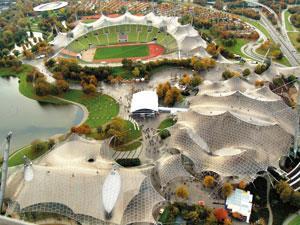A megalomaniac monument to the German plastics industry?

The 1972 Olympiad is a spectacular feast of exotic architecture that may become a megalomaniac monument to the German plastics industry. Dominating the 740-acre Olympics site, north of Munich’s city centre, is the world’s largest tensioned membrane structure, a 700,000?ft?sq, £20 million canopy of tinted Rohm & Haas acrylic Plexiglas covering the premium seats of the main stadium and extending in a crescent to envelope the swimming and gymnastics halls. Designed by German architect Gunter Behnisch, the huge transparent tent rests on a web of steel cables each 2.9 metres square acrylic section mounted in a neoprene frame and cushioned with neoprene buffers.
Like much of the technology at the 1972 Games, the roof material was dictated by colour TV considerations – the cameras will not tolerate a light-to-dark ratio of more than 1:3 so the roof had to be transparent enough to dispel shadows. The Rohm & Haas material selected unfortunately gave rise to massive heat loss and condensation problems in the covered sports and swimming halls. The solution was to suspend a second inner skin of PVC-coated polyester fabric under the Plexiglas roof, blotting out much of the light but saving millions in heating and ventilation installations.
Chemistry in Britain (September 1972)












No comments yet